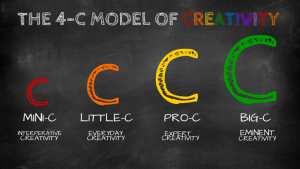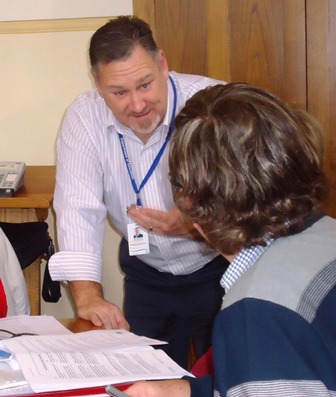A recent meandering conversation directed my thinking back to the notion of
“Big C – little c” creativity.
The origin of these terms is attributed to James C. Kaufman and Ron Beghetto who together created the Four-C Model of Creativity, which outlines different levels of creativity:
- “Big C” – genius level innovation and creativity – think Albert Einstein!
- “little c” creativity describes the small ideas and “a-ha’s” that enhance and enrich our lives — like creating a new recipe, teaching your dog a new trick or coming up with a new way to format a report for your company — but which rarely bring us fame or fortune.
Between Big and little c, lie two other variants:
- “mini-c” is the creativity that happens in the learning process. It could be a child learning to write a song.
- “Pro-c” is expert-level creativity. It might be someone who’s composed music that is currently popular.
Kaufmann illustrates the model like this:
 The life of a creative writer might progress through these stages as follows:
The life of a creative writer might progress through these stages as follows:
At a young age, Sally learns about writing poetry and tries many different forms. She writes a sonnet, a Haiku, and free verse. These poems may not be particularly good, but they are meaningful to her. This is mini c.
As she advances, she gets better. Maybe she reads some poetry at a coffee house and gets some poems published in her college literary magazine. Other people see some value in her poetry. This is little-c (we sometimes call this “county fair creativity”).
Sally keeps improving. She gets an Master of Fine Arts and teaches poetry at a college. She regularly publishes her work in respected journals. This is Pro-c.
If she is very talented and very lucky, Sally may eventually be considered a truly great poet. Even after she has died, her writing may be studied and enjoyed by generations to come. This is Big-C.
Ok, so I like this way of focussing on creativity. I think it allows us, particularly in schools, to look at the way we scaffold and develop creativity competency in learners.
But, I wonder if there’s another layer to Kaufmann’s model – in fact a “C on C” – Collaborative Creativity.
We acknowledge the power of the collective, of the whole being more than the sum of the parts. Of leveraging and acknowledging the best work of others…
I wonder also if Collaborative C, framed as part of a learning partnership, might enable learners to move, perhaps more rapidly, from an introspective mini-c toward Pro-C…and maybe together, hit Big C.
…So if we reflect on classroom conditions that support creativity, what might we do to uncover and build on mini c moments?
…How could we explicitly leverage Collaborative C?
…What might a community of creativity look like, sound like and feel like, for all learners, for all creators?
references and acknowledgements:
James C. Kaufman: https://en.wikipedia.org/wiki/James_C._Kaufman
Ron Beghetto: http://www.ronaldbeghetto.com/about/
Image source: https://phoenixhug.uberflip.com/h/i/60064060-the-science-of-creativity

